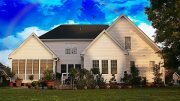From the spring of 2022, interest rates are expected to rise again. Then the current pace of increase in housing prices will also stop, DNB believes. The bank’s recent report Economic Outlook was published on Thursday.
In May, Norway became a member of the zero interest rate club together with other central banks around the world as a result of the pandemic. But for the Norwegian economy, there is improvement again, and in June Norges Bank adjusted the outlook for the economy and announced that interest rates could be raised in the second half of 2022.
However, DNB estimates in the report that we may have to expect an interest rate increase already in March 2022. And during that year and 2023, the interest rate will gradually rise to 0.75 per cent. At the same time, it is emphasized that there is uncertainty associated with the estimate.
“One type of risk we face is new rounds of infection control measures and the risk of closure that could weaken the recovery in the economy”, says macro analyst Oddmund Berg and senior economist Kyrre Aamdal.
Experts believe that Norway could be among the first central banks to start raising interest rates.
The party is over Norwegian families have kept their spirits up and received good income security at the same time as both monetary and fiscal policy have been given full throttle. Many in the population have a better financial situation in the short term. Interest rates have fallen and consumption is low as a result of reduced service offerings.
“At the same time, the housing market has managed to keep activity up, despite the infection control measures. This is probably the reason why inflation has been far higher than normal in May, June, and July”, Berg and Aamdal write.
In July, house prices were 4.9 per cent higher than in the same month last year. The low interest rates also make the housing market attractive as a money investment compared to putting money in the bank.
“Given the low interest rates and the relatively good financial position households currently have, we believe house prices will continue to grow at a good pace throughout the year and provide an annual growth of 4.1 percent for 2020”, say the experts who believe the increase will continue into 2021 with a house price increase of 6 percent.
“In 2022, we believe that the interest rate will be raised, and that will mean that the party is over for this time. In 2022 and 2023, we estimate housing growth to be 3 and 2.5 per cent”, respectively.
Wages This year’s wage settlement in the front subject ended at a limit of 1.7 per cent. The so-called overhang is 1.2 percent. This gives a tariff supplement of 0.3 percentage points and the remaining 0.2 percentage points are for local supplements and other adjustments.
This is very low and is due to the downturn in the Norwegian and international economy. DNB further estimates that in 2021 we will have a wage increase of 2.5 per cent as a real wage increase of 0.3 per cent and then a wage increase that rises to around 3 per cent.
The number of registered unemployed made one leap when the infection control measures took effect on 12 March. A number of workplaces such as restaurants and hairdressers had to be closed. Registered LFS vacancies increased less and more slowly since redundancies are not counted until after 3 months.
Over the summer, the numbers of registered unemployed have fallen
“We believe unemployment will continue to fall as more layoffs are allowed to return to work, although recent infection developments may have delayed this process”, the report states.
LFS unemployment is forecast to fall to 4 per cent in 2021 and stabilize at just under 4 per cent in 2022 and 2023.
Past the worst The bank believes that Norway is past the worst. As society has opened up, the economy has recovered.
In the second quarter of this year, gross domestic product (GDP) fell by 6.3 per cent, which is the largest fall Statistics Norway has ever measured for a quarter. This happened despite mainland Norway increasing the growth rate by 3.7 per cent in June.
“However, the growth rate towards the end of the quarter was good and indicates that we will have good growth in the second half of 2020. We estimate that mainland GDP will fall by 3.9 per cent for the year. By 2021, the growth rate will probably slow down somewhat”, according to the estimates.
Then the Norwegian economy can increase by 3.5 percent, in 2022 3.2 percent and 1.7 percent in 2023.
© NTB Scanpix / #Norway Today





Be the first to comment on "The housing price party may be over in 2022"